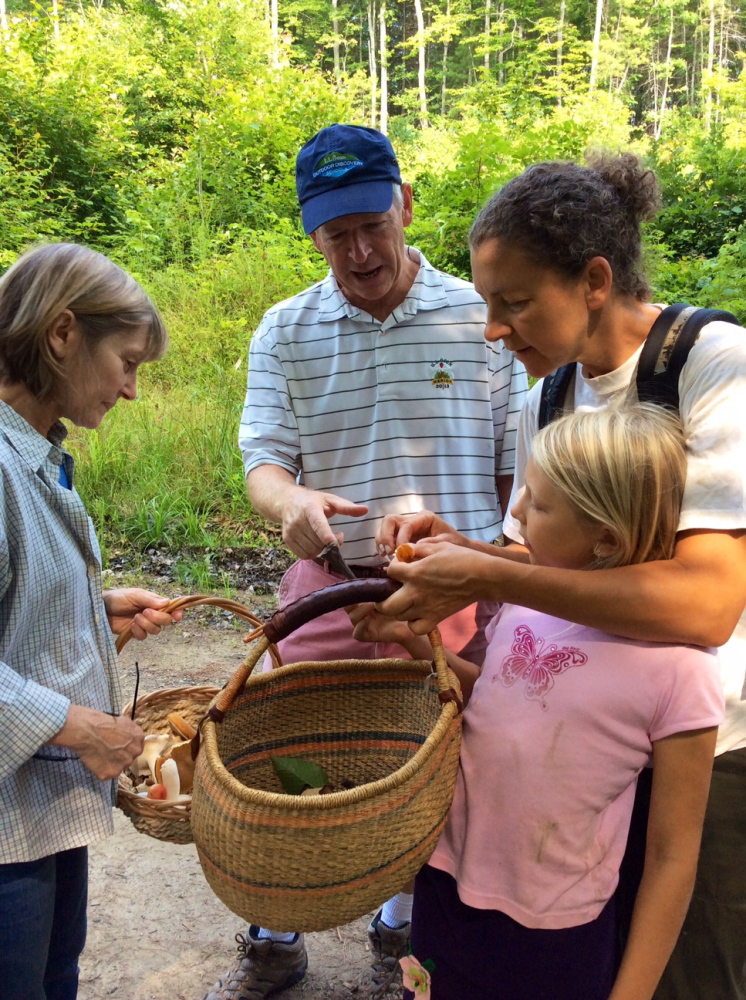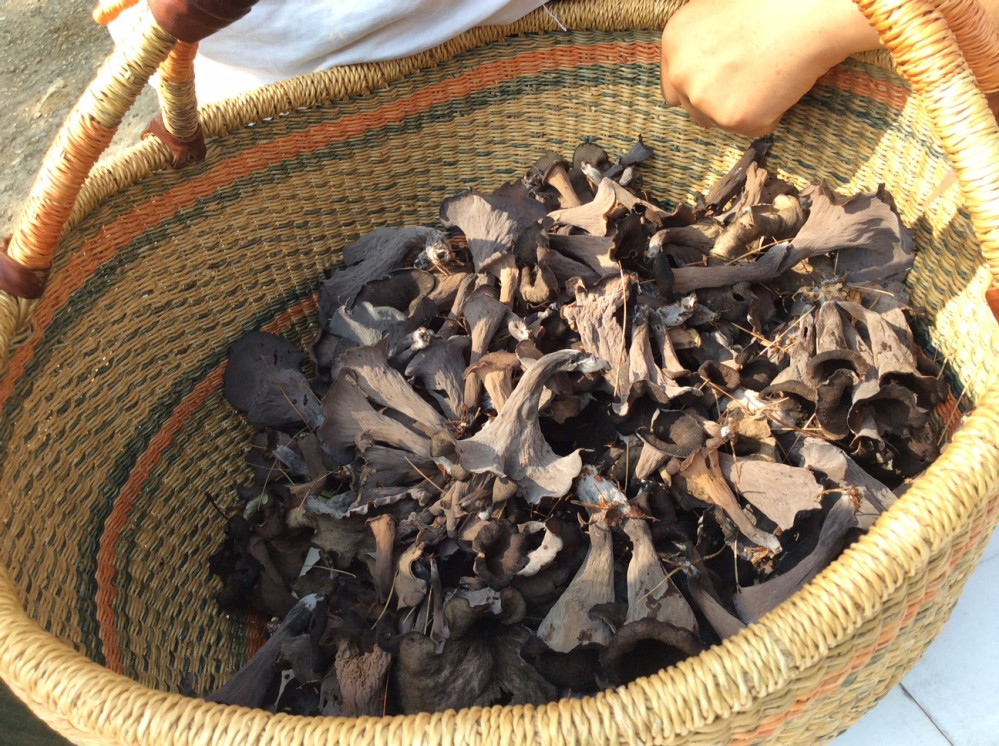When we relocated to Maine some two years ago now, I vowed that wild mushroom foraging would become my next foodie obsession. Since then, I’ve had the thrill of adding a mushroom or two to my admittedly still-limited repertoire. My family, like many other New England amateurs, focuses on the ubiquitous two that reward maximum taste from minimal effort: the earthy black trumpets now blaring from their green club moss backdrop and those yolk-yellow chanterelles.
Shortly after moving to Oregon, in fall 2008, I’d awoken to chanterelles on a Slow Food chapter’s forest foray, followed that evening by an exotic mushroom dinner at Sybaris Bistro. It was a seminal experience. In Oregon, we lived next door to research mycologists; sampled farmers market morels, hedgehogs and delicate yellow-foot winter chanterelles; tasted local truffles as I reported on rescue dogs training to sniff them out; and attended an annual wild mushroom banquet at a local community college – the dessert was panna cotta sweetened with maple syrup-esque Candy caps!
At the time, chanterelles were all I felt comfortable picking. But since moving to Maine, it’s been all about black trumpets. We’ve sautéed them with shallots, leeks and, of late, a Bowdoin colleague’s Chinese (garlic) chives, as an addictive bruschetta topping – we also love creamy chanterelle toasts. Trumpets marry well with gorgonzola in a rich pasta sauce, and incorporate into scrambled eggs and Asian stir-fries, such as the exquisite Thai noodle dishes at Long Grain in Camden.
Still, we’ve felt stuck in a black trumpets-and-chanterelles rut (OK, not such a terrible place to be). And I’ve wanted to up my game. I dream of stubby porcinis (whose apt name means “piggy” in Italian), but fear a look-alike bolete, implicated in several Northeast poisonings. My distrust of boletes, a varied genus that includes more than 100 species, only increased after attending a workshop at Wolfe’s Neck Farm two years ago with Greg Marley, author of “Chanterelle Dreams, Amanita Nightmares.” Marley’s only violent sickening in his vast amateur mycology career occurred almost 30 years ago when he ate a bolete that old field guides incorrectly listed as “edible.”
So last Saturday, my 3-year-old Theo and I joined my parents for our first Maine Mycological Association foray deep in the Whitefield woods, down bumpy dirt roads near Weary Pond. I paid my $10 dues to join the 300-member club, signing a hold-harmless waiver for any potentially dangerous mushrooms I might consume. We learned to identify edible orange-red lobster mushrooms and speckled painted boletes spread out on display tables next to toxic amanitas and other clusters of fungi families.
I was relieved Theo wasn’t the only kid there. Sasha Kutsy, who emigrated as a child from mushroom-loving Ukraine, and her daughter, Mirabelle, 8, of Belfast, filled their own deep basket with black trumpets. Kutsy says mushrooming is less instinctive for her than for her Ukrainian relatives, who eat almost all boletes and nibble on spicy, colorful gilled russulas raw in the field.
“Never eat a mushroom unless I feed it to you,” Kutsy cautioned her daughter. Despite the risk, she wants to give Mirabelle this visceral, ancestral and tasty connection to nature. “It’s a fun treasure hunt outside in the woods,” Kutsy said.
Now that I’ve got a child eager to imitate all his parents do, foraging is more fraught. We’ve taught Theo to pick strawberries (until realizing he may be full-body hives allergic), raspberries and blueberries, but now I worry he’ll think any attractive berry is fair game. “You can only pick berries with Mommy,” I tell him.
Carrabassett Valley nurse practitioner Olivia Goldfine had to call Poison Control when her fungiphile daughter Audrey, then 2, ate a raw yellow mushroom her mother worried might be a jack o’lantern instead of chanterelle. It wasn’t and Audrey was fine. But Goldfine is now more explicit about telling her girls, ages 3 and 1, never to eat the raw mushrooms they pick.
Greg Marley, who helps handle mushroom calls for the Northern New England Poison Control Center, writes that children under 5, curious toddlers and babies crawling close to the lawn are “a most common and indiscriminate mushroom grazer,” though fortunately 80 percent of frantic calls concerning kids who ingested mushrooms have a good outcome – the mushrooms turn out to be nontoxic. The other five groups Poison Control says are most at risk give parents (and others) years of worry:
• School-age boys in the dare-you-to-eat-anything stage;
• School-age girls with Alice in Wonderland red toadstool Disney fantasies
• Teens wrong about which are psychedelic psilocybin-containing “magic” mushrooms;
• Overly confident middle- aged males who are sure they remember what Granny collected; and finally,
• Immigrants who confuse poisonous mushrooms with edible ones from their homeland.
Given the mushroom mania here, it’s not surprising Maine has multiple cases of poisonings every year. “We do not want any misinformation attributed to us to be part of that problem,” warned Michaeline Mulvey, president of the Maine Mycological Association. So stick to the mushrooms you truly know and forage under the supervision of experts. And teach your children well.
A MUSHROOM MYSTERY
Or, well … sometimes it’s just easier to forage alone, say when I’m out for a run. That’s how I found a nacho cheese-colored specimen recently on the edge of a felled, rotting log. Some primal urge compelled me to snap it off, and inspect the soft yet springy, cream-yellow underside, which suggested chicken of the woods – though I did scrub my hands of its residue when I got home. I consulted two foragers, who seconded my identification, then toted my prize to mushroom-centric Trattoria Athena, where we were treating friends to dinner.
The menu already featured gnocchi with porcini and shaved black truffles served alongside six food-“clingy” wines poured. After sipping a revelatory aperitif, I walked my specimen back a couple paces into the fly-speck kitchen. Chef and co-owner Tim O’Brien and his sous-chef Matt DeFio, both experienced with wild mushrooms, confirmed it was indeed chicken of the woods, and agreed to sauté it alongside the tempeh they prepared for our guests, both vegetarians. We all took forest-to-table bites from the common pot.
“We’re already tripping,” I joked to sous-chef DeFio.
But something weird occurred later that night. I’m not one to have nightmares or talk in my sleep, but an hour after going to bed, I let out a blood-curdling scream, startling awake even Theo in the adjacent room. I swear I saw a bearded, shadowy figure trying to break in our bedroom window. Must have been all that velvety wine?
Luckily, Theo and I soon snuggled back to sleep. Did I dream of something more reassuring, then? Of one day bagging fat porcinis, with Theo at my side?
CREAMY BLACK TRUMPET MUSHROOM AND GORGONZOLA PASTA
This recipe comes from my parents’ Maine neighbors, Dan “Tree” Robbins and Elaine Eadler. When my mom enthused about the locally foraged Maine black trumpets in this “AMAZING” pasta dish, my sister Elaine replied, “Are you sure they weren’t hallucinogenic mushrooms? You sound high in your email.”
Makes 4 generous servings
1 ounce dried black trumpet mushrooms (or as many as possible if fresh are available)
2 to 4 tablespoons butter
1 to 2 shallots, minced
1 cup heavy cream (or half-and-half)
1 ounce Gorgonzola dolce
1 pound penne pasta
Salt and freshly ground pepper
Fresh minced parsley and tarragon
1 cup fresh grated Parmesan Reggiano
Soak the dried mushrooms in warm water for 30 minutes. Strain the liquid through a coffee filter (and reserve the liquid for this sauce or another purpose). Pat the mushrooms dry and clean with a paper towel to wipe off any sediment.
Or gently trim, rinse and dry your fresh mushrooms and chop the texture you like best.
Melt butter in a large skillet and add shallots. Sauté about 7 minutes, until softened and starting to brown.
Add mushrooms and cream. Stir in the gorgonzola. Simmer 10 minutes.
Meanwhile, cook the penne in boiling, heavily-salted water until al dente. Add the cooked pasta to the skillet with the sauce, stirring well to combine. Salt to taste. Stir in the parsley, tarragon and the Parmesan. Serve immediately, with freshly ground pepper.
Send questions/comments to the editors.




